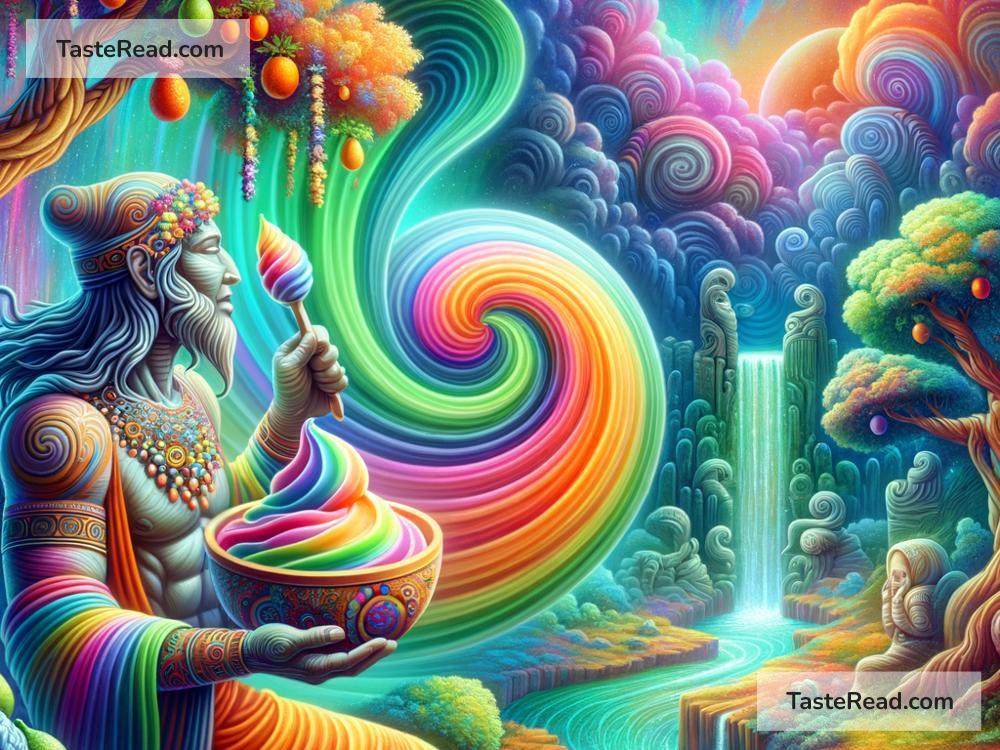The Origins of Rainbow Sherbet in Ancient Tales: A Sweet Journey Through History
Rainbow sherbet is a colorful and delicious treat that many of us enjoy today. Its vibrant swirls and fruity flavors make it a favorite dessert, especially during hot summer days. But have you ever wondered where rainbow sherbet came from? While modern versions of sherbet have a clear origin in recipes from the past few centuries, there are ancient tales that hint at the idea of frozen fruit desserts long before sherbet became the dessert we know today. Let’s explore the fascinating stories tied to the roots of this colorful sweet treat!
The Early Idea of Frozen Desserts
Rainbow sherbet, which combines three or more fruity flavors, is a type of “sherbet.” Sherbet—different from ice cream—is a frozen dessert made with fruit juices, sugar, and sometimes milk. While sherbet as we know it today may have been perfected in the 19th and 20th centuries, the idea of mixing frozen flavors goes much further back.
Historians believe that the earliest hints of frozen desserts came from places like ancient Persia (modern-day Iran) over a thousand years ago. The Persians were believed to have created the ancestor of sherbet by mixing fruit juices with snow or crushed ice gathered from mountains. Ancient rulers and royalty would send workers to retrieve fresh snow, which was kept in deep, insulated pits to preserve it throughout the year. This snow was flavored with syrups made from fruits like pomegranate, cherry, or orange, creating an early version of what we now call sherbet.
The Persians called their chilled dessert “sharbat” or “sharbet,” a term that closely resembles our modern word “sherbet.” The sharbat drinks and icy desserts were seen as luxurious foods for royalty and the wealthy. These frozen creations weren’t colorful like rainbow sherbet but laid the foundation for the sweet and fruity mixes we later developed.
A Taste of Magic in Mythology
While historical records tell us a lot about how frozen fruit desserts started, ancient tales have added a magical touch to their origin. In some mythical stories, rainbow sherbet is described as a gift from the gods. The rainbow itself often symbolizes hope, joy, and abundance, and many cultures around the world have legends about rainbows appearing after storms as a sign of good fortune.
One such tale comes from ancient Greece. In Greek mythology, Iris was the goddess of the rainbow and a messenger of the gods. It was said that Iris would carry sweet dew and nectar from Mount Olympus down to Earth, spreading these gifts through colorful streaks in the sky. Some stories suggest that Iris’s nectar—which was fruity, icy, and vibrant—was the inspiration behind the idea of combining flavors in desserts. Although her rainbow nectar is likely just a romantic legend, the connection between rainbows and sweet indulgence has a special place in storytelling.
Another story comes from Chinese folklore. In one ancient tale, a magical cook in the emperor’s palace received inspiration to create a dessert that mirrored the beauty of rainbow clouds at sunset. After mixing crushed ice with fruit juices of different colors—such as plum, mango, and lychee—he created a dessert that captured the beauty of the skies. This colorful, icy dish was said to impress the emperor so much that it became part of royal banquets.
Evolution Into Modern Sherbet
Although these ancient myths and legends give the origins of rainbow sherbet a magical spin, the actual dessert itself underwent centuries of evolution. During the Middle Ages, the knowledge of Persian sharbat spread to Europe through the trade routes. Europeans refined it into a dessert that used sugar and dairy, which eventually led to the creation of sorbet and sherbet styles.
It wasn’t until the 1700s and 1800s that frozen desserts experienced major advancements with the introduction of refrigeration technology. Instead of relying on natural snow and ice, people could make frozen treats year-round. Rainbow sherbet, with its combination of fruity flavors and colors, emerged in the early 20th century, particularly in the United States. Cooks experimented by layering different fruit-flavored sherbets like raspberry, orange, and lime to create the eye-catching swirls we know today.
The Symbolism of Rainbow Sherbet
Though its modern-day creation may be rooted in culinary innovation, rainbow sherbet has ties to ancient origins and mythology that make it more than just a dessert. The rainbow colors remind us of nature’s beauty and our connection to ancient tales of hope, creativity, and magic. Its sweet flavors also bring people together, whether for a summer gathering or a birthday celebration.
Conclusion
Rainbow sherbet may seem like a simple frozen treat, but it carries the legacy of centuries of creativity and wonder. From ancient Persia’s snowy sharbat to mythical stories of rainbow-colored nectar, the idea of colorful, icy desserts has delighted humanity for generations. Today, when you scoop up some rainbow sherbet, you’re not just enjoying a sweet treat—you’re taking part in a colorful history and a tradition of celebrating life’s brightest moments.


